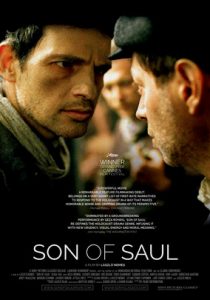Son of Saul-2015
Director Laszlo Nemes
Starring Geza Rohrig
Scott’s Review #520
Reviewed November 16, 2016
Grade: A
Son of Saul, arguably the deserving winner of the 2015 Best Foreign Language Film Oscar, is a grim yet refreshing and inventive look at a subject matter that has been covered in great length in cinema.
The topic is a heavy one and to describe the film as a downer is justified, but there is also something brave and even heartwarming about this film, and the central character’s desire to do something decent in the face of death and hatred.
The film is Hungarian and takes place in 1944 when Saul is a prisoner in a Nazi extermination camp. He is given various duties, considered a “glorified” prisoner, as he takes valuables from the belongings of those gassed, and scrubs the floors after the gassing has occurred.
He later must dump the dead bodies into a pit to be incinerated.
One day, after a group of Jews, are gassed, a young boy is miraculously still breathing. Soon after being discovered, the boy is suffocated. Convinced the boy is his son, Saul is determined to bury the boy properly for religious purposes.
I was immediately struck by two aspects of Son of Saul that separate it from the pack; the camera work, and the coloring.
The character of Saul is immediately shoved in our faces from scene one allowing us to see things from his point of view. Extreme closeups of Hungarian actor Geza Rohrig overwhelm the viewer as suffocation is apparent.
When close-ups are not used, we are treated to the camera following Saul around as he performs his duties without emotion, clearly having done them on multiple occasions.
We become Saul and experience activities solely as he sees or hears them. This is understated yet compelling.
Secondly, the film contains a rustic, beige color, mixed with sickly greens and yellows- muted almost, which is highly effective given the amount of death involved.
Not glossy, the color scheme portrays a sense of ruin and discourse without overwhelming or going for total bleakness. The style is a dusty, smoky variety, nauseating at times. I found this to separate Son of Saul from other films with the same subject matter, making it quite distinctive.
Not a happy film and neither is the piece a complete downer that will leave one entirely depressed. Saul’s intentions to give his son a decent burial (and it is unclear if the boy is Saul’s son or hoped to be) is admirable and a small glimmer of goodness in a world that contains evil.
Other prisoners aid Saul in his efforts, telling us that their world is not without hope.
Still, despite the goodness of some of the prisoners, a couple of scenes are tough to take. Early on, dozens of people are huddled-naked, into a small room. They are promised coffee, jobs, and most importantly, hope.
Sadly, the viewer quickly realizes that the intention is to exterminate them, though the film wisely does not visually show this. A brilliant distinction to Son of Saul is the background sound and what is happening near Saul.
We hear the gasping, the pleading, and the screaming of the victims, while the camera stays on Saul and his stoic reactions.
We realize this is a typical day in his life.
Deserving of its accolades in a year of exceptional foreign language films, Son of Saul (2015) takes a familiar subject matter and gives new and unique elements to it.
The film also departs on a cliffhanger involving a second young boy, a clever moment in an already superior film.
Oscar Nominations: 1 win-Best Foreign Language Film (won)
Independent Spirit Award Nominations: 1 win-Best International Film (won)
